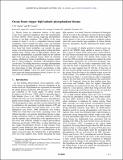Ocean fronts trigger high latitude phytoplankton blooms
Author(s)
Taylor, John R.; Ferrari, Raffaele
DownloadFerrari_Ocean fronts.pdf (636.1Kb)
PUBLISHER_POLICY
Publisher Policy
Article is made available in accordance with the publisher's policy and may be subject to US copyright law. Please refer to the publisher's site for terms of use.
Terms of use
Metadata
Show full item recordAbstract
Density fronts are ubiquitous features of the upper ocean. Here, numerical simulations show that restratification at fronts inhibits vertical mixing, triggering phytoplankton blooms in low-light conditions. The stability of the water column at fronts is set by a competition between frontal instabilities, which restratify the upper ocean, and turbulent mixing, which acts to destroy this stratification. Recent studies have found that frontal instabilities can restratify the upper ocean, even in the presence of strong surface cooling and destabilizing winds. During winter at high latitudes, primary production by phytoplankton is generally limited by low ambient light levels and deep turbulent mixing. When the turbulent mixing, inhibited by frontal restratification, becomes smaller than a ‘critical turbulence’ threshold, a phytoplankton bloom can develop. The finding that fronts can trigger phytoplankton blooms by reducing mixing, provides an explanation for satellite observations of high chlorophyll concentrations at high latitude fronts.
Date issued
2011-12Department
Massachusetts Institute of Technology. Department of Earth, Atmospheric, and Planetary SciencesJournal
Geophysical Research Letters
Publisher
American Geophysical Union (AGU)
Citation
Taylor, J. R., and R. Ferrari. “Ocean Fronts Trigger High Latitude Phytoplankton Blooms.” Geophysical Research Letters 38.23 (2011). ©2011. American Geophysical Union.
Version: Final published version
ISSN
0094-8276